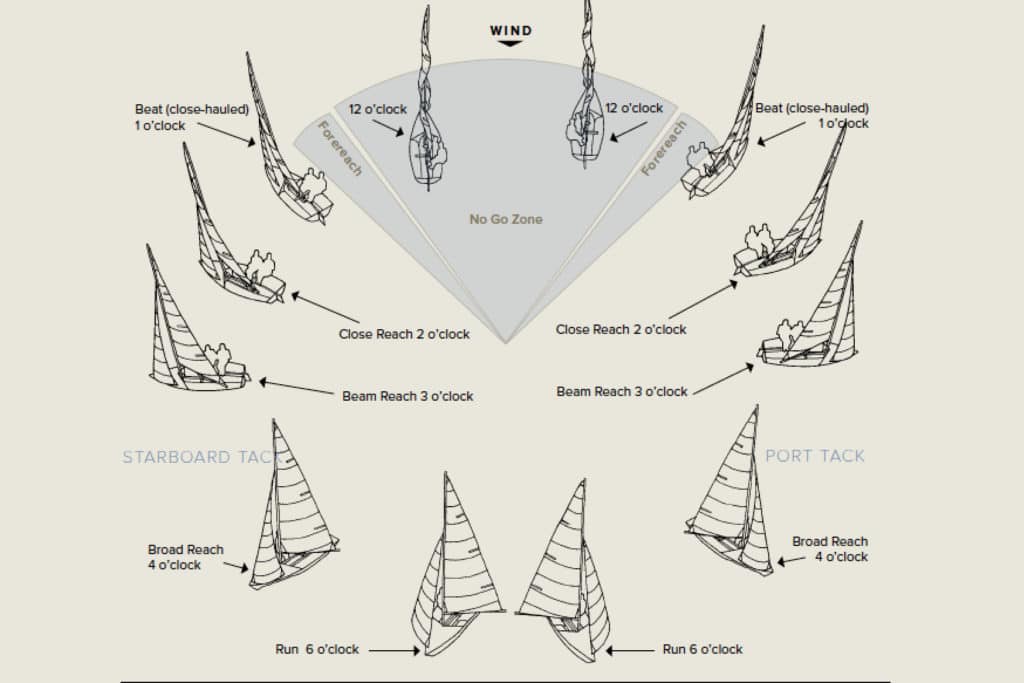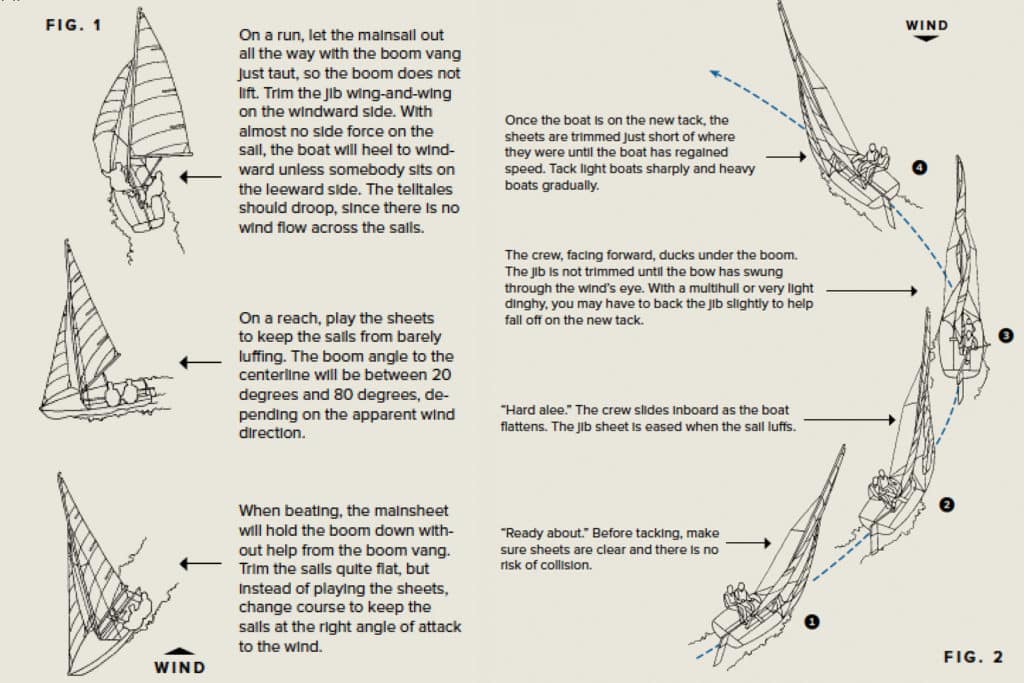
Points of Sail
“The idea of sailing a boat upon the sea can seduce even the happiest farmer or mountain climber. There is something about boat and water that sends romance churning in our hearts, and simply the sight of a boat can inspire a reverie.”
I wrote those words in the first edition of my sailing manual, The Annapolis Book of Seamanship, in 1983. They’re still there today in the updated fourth edition, published in 2014. And yet, as deeply as I feel about boats, I’m certain that when you’re afloat, romantic and magical thinking is no substitute for basic skills and fundamental knowledge.
To quote some other words I wrote back then: “Limitless in her poetry, a sailboat is still restricted by the realities of wind and sea.” Here I’ll describe some important basic skills when learning to sail for dealing with a few of those realities, including some tips and tricks of the seaman’s trade that I have learned and that should make you a more able, safe and confident skipper or crew.
How to Start Sailing
The very first step when you go sailing is to properly prepare yourself for the sometimes demanding and harsh elements you will encounter on the water. Take a wide-brim hat, a waterproof jacket, nonskid sneakers and, of course, a life jacket that fits you securely. Wipe on a gob or two of high-SPF sun lotion, and take the tube with you so you can continue to apply it lavishly. Those who suffer from motion sickness should consider taking a medication, preferably one that you’ve tested for side effects. Before heading out, write up a float plan including your itinerary and important contacts and share it with your friends and family, or your sailing club.
The most unsettling moment of a new sailor’s first day learning to sail often comes when you climb on board and feel the boat move under you. There’s plenty of reserve buoyancy, but if the boat’s small and skittish, you should step into the center of the cockpit. A bigger boat can be boarded via the side deck, but even it may sway and settle a little. Forget about looking graceful. Take advantage of any handhold you can grab.
Once everyone is on board, the skipper must assert command. To quote a wise captain and safety instructor, Karen Prioleau: “When leadership is obscure, tight situations get even tighter.” Assignments are made, gear is stowed, the bilge is pumped, an inspection is conducted to see that all is in order, sails are prepared to hoist, and plans are made to get underway. If the boat has a motor, it can be used to get away from the mooring or dock into open water before setting sail. But for now, let’s concentrate on getting underway on an engineless boat. Start by setting the mainsail, the big sail. The line to the boom (called the mainsheet) must be well eased so the sail, once set, spills wind (luffs) and doesn’t fill prematurely. The boom will flop around, so keep your head low and consider controlling it with a line called a preventer.
Trimming and Tacking a Sailboat

When the skipper says to cast off, up goes the jib, the smaller sail on the bow, also with a loose sheet. Casting off under sail is a little complicated because the boat isn’t moving, which means the rudder has little to no effect. That’s why the boat must be steered with the sails until there’s enough speed (or “steerageway”) for rudder steering. When learning to sail, start with the boat hanging off the mooring or pier; the sails will luff because the wind is blowing from directly ahead. If you’re looking at the bow, you’ll feel the wind on both ears. That angle is sometimes called the “wind’s eye.” Trim the jib—using the winch to bring the sail in, not let it out—to the side opposite the one where you want to sail. If you want to head off to the port side, you “back the jib,” or trim it to the “wrong” side. As the backed jib pulls the bow off, cast off the mooring. Once the wind is on that side, trim the jib to the correct side while also trimming the mainsail as the boat accelerates. In this way, the sails help steer the boat.
An entertaining and educational exercise is to sail a boat toward a buoy or other target on a reach, with the wind coming from the side (or beam) of the boat, and do a series of slow weaves as the sheets are eased and trimmed. When the skipper at the helm and the sail trimmers are in sync, everything goes well (see Figure 1). If you get nervous, slow down by easing the sails until they are just half-filled with wind.
Practice changing tacks. If you start off with the wind coming over the starboard side, you’re on the starboard tack. If the wind is on the port side, you’re on the port tack (see Figure 2). One of the two ways to change tacks is called “coming about,” or “tacking.” The helmsman starts the process by saying, “Ready about,” and after the crew answers that they’re ready, “Hard alee.” With a strong, fluid shove of the tiller or turn of the steering wheel, the bow passes through the eye of the wind and comes off onto the new tack (see Figure 3).
The other way to change tacks is to jibe, pulling the tiller or wheel in the other direction, easing the sheets out, and swinging the stern through the wind’s eye until the boom swings across (see Figure 4). The steerer’s commands are “stand by to jibe” and, after the crew acknowledges, “jibe-ho.” The boom will come across suddenly and rapidly, so all crewmembers must be careful to duck their head as they trim the mainsail and jib to the new sides.
Since we are talking about steering, this may be the place to encourage you to steer from the windward side of the tiller or wheel. The windward side (closer to the wind direction) is higher than the leeward side (farther from the wind) when the boat is heeling, so you will have greater visibility to see “puffs” of wind (the dark shadows moving across the water) as they approach.
Using Telltales
One phenomenon of sailing is that as the boat speeds up or slows down, the wind seems to change direction and force. That’s because there are two types of wind. One, called “true wind,” is the breeze you feel when standing still. The true wind’s velocity and direction are the same for all nearly stationary objects. But if one of those objects moves (like a boat does), its motion affects the true wind to create “apparent wind,” which is felt by people on the moving object.
Sails are trimmed to the apparent wind. You can gauge the apparent-wind direction and force by feeling it on your skin, reading it on an electronic instrument, or seeing it on a telltale, which is a short length of yarn tied to one of the boat’s side stays (shrouds) that support the mast. While all those devices indicate the wind direction, none of them tells you if your sails are trimmed correctly for that direction.
Sails are airfoils, with a deep curve that redirects the apparent wind to produce a force that pulls the boat forward (somewhat like a wing lifting an airplane off a runway). Side force is absorbed and redirected to forward force by the airfoil-shaped fins under the boat, the centerboard and keel. As airfoils, sails should be trimmed to suit the wind, and the boat should sail the most effective angle to that wind.
A simple, effective indicator of that sailing angle is a set of short lengths of special telltales—yarn or ribbons—that are sewn or glued to sails. Some telltales are placed on the jib, near its leading edge (the luff), on both sides of the sail. Ideally, there should be three pairs of jib telltales at equal intervals up and down the sail’s luff. But one pair about halfway up the sail should do the job. Other telltales are secured, one at a time, on the trailing edge of the mainsail (the leech), or at least at or near the second batten from the top. The jib telltales on both sides of the sail should stream aft most of the time, with the windward ones lifting slightly from time to time. The mainsail leech telltale should stream aft about half the time. If your telltales behave differently, try steering closer to or farther off the wind, and experiment with sail trim. An inch or two of sail trim or ease can get them flowing again and make the boat sail faster.
Sailing Rules of the Road
Once you’re sailing, you may be near other boats and worried about who is under an obligation to alter course to avoid a collision. The basic rule is that more maneuverable boats must give way (change course) to avoid boats that are less maneuverable and that, therefore, may continue on their course, giving them right of way. (These are sometimes called “stand-on vessels.”) Usually powerboats must give way to sailboats, but all smaller boats, sail and power, must give way to big ships in a narrow channel and other vessels requiring room to maneuver.
There are a few other basic rules. When one boat is overtaking another, no matter what type, the overtaking boat must give way. When boats under power meet each other bow to bow, they each should turn to starboard so they pass port side to port side. And when sailboats are sailing near each other, without engines turned on, the one on the port tack (with the wind coming over the port side) is obliged to give way to the one on starboard tack. But even if the rules give you the right of way, proceed just as sensibly and defensively as you would when you face the realities of wind and sea at other times in open waters.
Once you’ve mastered these basics, get out on the water as often as possible to hone your skills in all conditions. One of the great things about sailing is that no matter how many miles you cover, there’s something new and different to experience every time you set sail. Congratulations on taking the first step toward what, for so many of us sailors, has become an enjoyable, lifelong pursuit.
Renowned sailing writer John Rousmaniere has logged over 40,000 nautical miles of bluewater sailing, including nine Newport-Bermuda races. This article is based on material from the fourth edition of his comprehensive sailing manual, The Annapolis Book of Seamanship (Simon & Schuster, 2014).








